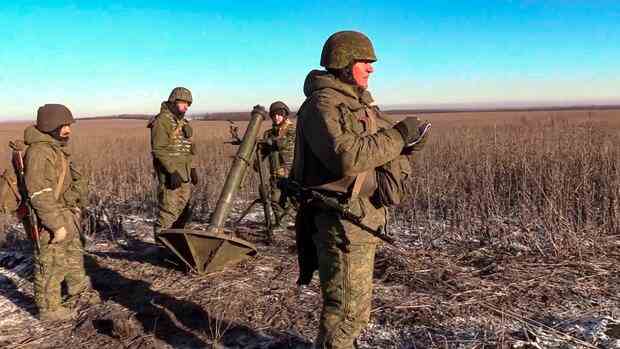Kyiv A small coal-mining town on the Eastern Front has become a strategic point in the struggle for Donetsk province. Wuhledar – which roughly translates to “gift of coal” – is situated on a hill, one of the few higher places in the area. The Ukrainian forces have been able to hold the city center so far, while the Russian invaders are positioned in the suburbs.
If the attackers manage to take the city, it would be an important step towards disrupting Ukraine’s supply lines. A trunk road runs not far away, an important supply route for the defenders. Conversely, if the Ukrainians can secure Wuhledar, that would give them a potential launch pad for a future counter-offensive to the south. In other words, whoever controls this city near the administrative border of Donetsk province has a tactical advantage in the battle for the Donbass region as a whole.
“The main focus of Russian military efforts is in Donetsk, and Wuhledar is basically the southern flank of that,” says Gustav Gressel, a senior expert at the Berlin office of think tank European Council on Foreign Relations.
The town had a population of 14,000 before the war, now it’s only around 300. Most of the population worked in coal mines or in nearby factories – like Olha Kyseliowa before the war changed everything. According to surviving residents, Russian troops began stepping up their attacks on January 24. That day, a rocket hit the nine-story apartment building where Kyseliowa lived. She took shelter in the basement with her three children and found her apartment badly damaged, with a yawning hole in the ceiling.
That was the moment when, with a heavy heart, she decided to leave her hometown. “I cried the whole way out,” she says. “I didn’t want to leave.”
The tactical importance of the city is clear to both sides
Three Ukrainian brigades are stationed in Wuhedar and its outskirts. The AP news agency spoke to five commanders from various units, all of whom gave only their first names, in accordance with Ukrainian military regulations. Russia has positioned marines only about four kilometers away. The tactical importance of the city is clear to both sides.
“It is one of the main logistical points of the Donbass region and also one of the main points at higher altitudes,” says Maxym, deputy commander of a Ukrainian naval infantry battalion. “If they capture Wuhledar, the Russians can easily occupy the entire Donetsk region.”
According to Gresser, if the city were captured, the Russian attackers would be able to advance and threaten the supply lines to the Marinka front. Conversely, if the Ukrainians could hold and stabilize Wuhledar, that would be a suitable starting point for future counter-offensives in the direction of Mariupol and Berdyansk.
From their position in the city, the Ukrainian forces can see into the Russian lines and have so far been able to prevent an encirclement of Wuhledar. Columns of Russian tanks and armored vehicles with infantrymen keep trying to break through the Russian defenses. The city is being bombarded from the air and from the ground. “But thanks to our fighters and our anti-tank equipment, their attempts were unsuccessful,” says Maxym, the deputy commander. “The situation is tense, but controlled.”
>> Read also: Biden wants to lead the West – but the alliance against Putin faces an uncertain future
Similar to other front lines in eastern Ukraine, Russian troops are losing numerous infantrymen trying to fatigue and weaken Ukrainian defenses. Serhiy, the commander of a Ukrainian reconnaissance unit, says he saw Russian soldiers being sent straight through fields mined by Ukrainians after the Russians took the village of Pavlivka south of Wuhledar in November. “They are clearing the mines from our fields using their own people.”
“Trying to find our weak points”
Two commanders of a brigade in Wuhledar report Russian projectiles with gas that have caused severe disorientation for hours and burning in the throat and on the skin. “They’re testing us along the eastern front line, including Wuhledar,” says Olexandr, another commander. “They try to find our weak points.”
So far, Russia’s activities around the city are not significant from an operational standpoint, says Russian analyst Kateryna Stepanenko of the US-based think tank Institute for the Study of War. More combat power is required to effect the breakthroughs needed to achieve the stated goal of the Russian invasion – the capture of the entire Donetsk province.
According to British military experts, Wagner mercenaries and regular Russian troops have advanced on the eastern Ukrainian cities of Bakhmut and Wuhledar in the past few days.
(Photo: dpa)
Even if the Russians captured Wuhledar, they would need a lot of fighting power to push north, Stepanenko explains. After all, three months after capturing the village of Pavlivka, they still haven’t made a breakthrough in Wuhledar, even though the town is only four kilometers – a six-minute drive – away.
Meanwhile, the last of Wuhledar’s residents are determined to stay, despite Olexandra Hawrylko, the Donetsk region police spokeswoman, having repeatedly urged them to leave the devastated area. Most of those who remain spend their days in basements, coming out during lulls in combat to charge their cell phones and pick up supplies at designated havens around the city called “Invincible Hubs.”
With one exception, all of the minors from Wuhledar have been taken to safety elsewhere, Hawrylko says. The father of a 15-year-old refuses to separate from his son or leave town. Some just didn’t want to leave, “we tried many times,” says Hawrylko. Most would never have traveled far from their hometown in their lives.
More: Biden wants to lead the West – but the alliance against Putin faces an uncertain future
